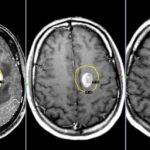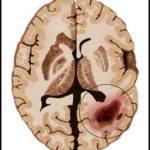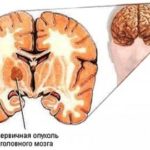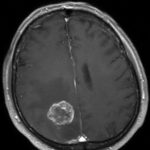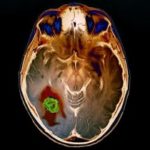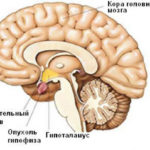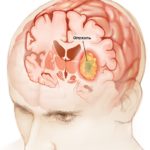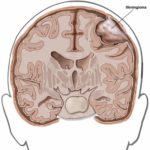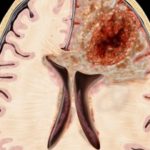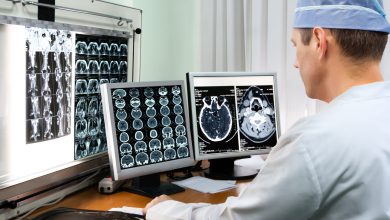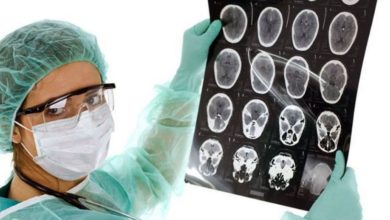A brain tumor. Stages, photos of tumors
The content of the article
The problem in diagnosing such a disease is that its symptoms are very easy to confuse with other diseases. For example, dizziness, nausea and vomiting can be symptoms not only of a brain tumor, but also of migraine or hypertensive crisis. That is why successful treatment of brain cancer begins with the selection of a qualified specialist who can establish an accurate diagnosis and prescribe prompt treatment.
Causes
To date, the exact reasons why brain cancer occurs have not been studied, photos of which will allow us to understand the consequences of such a terrible disease. Experts note that primary tumors are mainly caused by gene pathologies, while secondary tumors arise as a result of metastasis of other tumors.
There are several reasons that can trigger the appearance of brain cancer:
- Genetic diseases. In medical practice, it is noted that brain cancer is very often diagnosed in patients who suffer from Bourneville disease, tuberculous sclerosis and others;
- Weakened immunity. Often, a brain tumor is diagnosed in patients who have undergone organ transplant surgery or who have AIDS. In the second case, cancer more often occurs in other organs, and then metastasizes to the human brain;
- As practice shows, brain cancer is more often diagnosed in women than in men. Not only gender, but also race plays a big role: it has been noted that white-skinned people suffer from brain cancer much more often than representatives of other races;
- The negative impact of radiation and carcinogens, which have a high oncogenic danger, resulting in a significantly increased risk of developing a brain tumor. The risk group includes people who work in hazardous industries;
- Age. Brain tumors are more common in adults, and at older ages, malignant neoplasms are much more difficult to treat. Children are also at risk of developing this disease, but unlike adults, the location of the tumors will be different: in adults, the tumor affects the membranes of the brain, while in children the brain stem or cerebellum is affected.
Brain Cancer: Symptoms and Signs
Brain cancer, photos of patients for which can be found on the Internet, may differ in focal and general cerebral symptoms. In the first case, everything depends on the location of the tumor, and as for general cerebral symptoms, they are identical for all cases of brain cancer.
Focal symptoms include the following:
- The patient begins to perceive various feelings distortedly, tactile sensations can be quite strange, and a complete or partial impairment of the mobility of the limbs is often diagnosed;
- There may be a complete disruption of mental processes, as a result of which the patient becomes unpredictable, aggressive, and completely passive. Increased attacks of apathy and depression may also be observed;
- The patient experiences problems with urination or bladder function.
Brain tumors have characteristics and general symptoms, among which it is worth noting increased intracranial pressure. In addition, it is noted:
- Dizziness, possible feeling that the ground is disappearing from under your feet. In the latter case, a thorough diagnostic study is required;
- Headaches that may initially be periodic, but after a short time become constant. Most often occur after sleep, before eating, after physical activity or emotional stress;
- Nausea and vomiting. They mainly occur as a result of a sudden change in head position. Vomiting may occur without signs of nausea and is not associated with food intake. This symptom severely dehydrates the body, which is why patients are prescribed medications that block this symptom.
Stages 1 and 2 brain cancer
The asymptomatic course of the disease does not allow us to visually accurately assess the stage of the tumor; moreover, the transition from one stage to another occurs very quickly and imperceptibly, especially when it comes to tumors in the brain stem.
- Stage 1. At this time, a minimal number of healthy cells are affected. The tumor can be easily surgically removed, and recurrence is quite rare. It is very difficult to detect cancer at this stage, since the symptoms are very similar to other diseases. To accurately diagnose stage 1 cancer, it is necessary to conduct a special study. The patient feels weakness, increased drowsiness, periodic headaches and rare dizziness. Often patients neglect the need to consult a specialist, as they attribute these symptoms to reduced immunity or changes in weather;
- Stage 2. During the transition from the first stage to the second, the tumor begins to affect more and more healthy cells and compresses the brain centers. The most dangerous symptoms include convulsions and epileptic seizures. Vomiting and problems with digestive function may also occur. In this case, the tumor can still be surgically removed, but the chance of a complete recovery is reduced;
Stages 3 and 4 cancer
- Stage 3. At the third stage, the tumor begins to grow very quickly and affects a sick number of healthy cells. At this time, a benign tumor can degenerate into a malignant one, making it almost impossible to remove it surgically. If the tumor is localized in the temporal lobe, then the chance of successful surgical removal increases. As for the symptoms of stage 3 cancer, the existing symptoms intensify, serious damage to hearing, speech, and vision is observed, while the patient becomes difficult to concentrate, he exhibits severe absent-mindedness , and memory is also impaired. Limbs may fail partially or completely. The function of the vestibular apparatus is severely impaired, making it very difficult to maintain balance when the body is in a vertical position. A characteristic symptom of stage three cancer is horizontal nystagmus. In this case, the patient’s pupils begin to dart strongly, while the head remains motionless. Only another person can see this, since the patient himself does not notice it;
- Stage 4. In this case, the tumor affects important parts of the brain, making surgical intervention no longer possible. Specialists use palliative techniques, drug treatment, prescribe radiation therapy, and also prescribe strong painkillers to the patient. Basically, the prognosis is disappointing, but it all depends on the patient’s immunity, as well as his emotional state. The symptoms here are associated with the loss of important functions, which occurred as a result of the malignant process. The low effectiveness of treatment leads to the patient falling into a coma, from which in most cases he does not recover.
Photos of tumors
click on photo to enlarge
Diagnostics
- Visual inspection by a specialist. The initial examination involves the patient performing certain actions that help the specialist evaluate impairments in tactile or motor function. The patient may be touched with a finger to his nose with his eyes closed or walked after spinning around himself;
- MRI . A brain tumor will be best seen on an MRI; photos of the procedure can be found on the Internet. MRI allows you to accurately see the location of the disease, as well as detect a tumor at an early stage of development ;
- Biopsy. It’s worth noting right away that this method is not always applicable, since the tumor may be located in a hard-to-reach place and taking part of the tumor for analysis is not always easy. Otherwise, this diagnostic method allows you to familiarize yourself with all the features of the tumor and prescribe the most effective treatment;
- Radiography. The patient is injected with a special contrast agent, which allows the location of the tumor to be seen in the image of the blood vessels.
Only after diagnosing a brain tumor will it be possible to prescribe the correct treatment for the disease.
MRI as one of the main diagnostic methods
MRI of the brain is a non-invasive study that includes several important components, which results in an accurate image of the patient’s brain. If you are interested in what a brain tumor looks like on MRI images, you can find a large number of photos on the Internet. The main advantage of this diagnostic method is that it does not use X-rays. As a result, MRI is the safest and most accurate examination of tumors in the head. Very often it is diagnosed accidentally, and the procedure itself was prescribed to detect other pathologies.
There are two types of MRI of the brain:
- no contrast;
- with contrast.
The first option involves the use of a special substance that is administered to the patient, which as a result increases the contrast of various tissues. This option is more effective, but it must be used very carefully, since the injected substance can cause severe allergic reactions.
Preparation for the procedure
Basically, no preparatory work is required before the procedure. In some cases, the patient may be asked not to drink or eat before the MRI. To diagnose a brain tumor, the patient will need to remove all metal jewelry and wear a loose hospital gown. As a last resort, you can stay in your clothes if they are spacious and there are no metal parts on them.
Women who are pregnant are required to notify the doctor about this before the procedure is performed. Medical practice confirms the fact that over the past 30 years, the MRI method has not had a negative impact on the health of the mother and fetus. But it is still too early to talk about the complete safety of carrying out such diagnostics on pregnant women. You should inform the specialist about recent operations, metal plates installed inside, as well as the presence of allergies.
How is the procedure given?
The diagnostic device is a large cylinder with holes on the sides. Inside the device there is a movable table on which the patient is placed. There are devices that have a short tunnel and are used for very obese patients or those who suffer from very severe claustrophobia. The capabilities of such devices, in comparison with conventional ones, are limited.
The patient is placed on the table and secured with special belts. While still, specialists are able to obtain the clearest possible image, which allows them to accurately diagnose brain cancer from photographs of patients. During the procedure, special devices are placed around the patient's head that send and receive radio waves. Patients are often given earplugs to help them comfortably tolerate the loud sound of the device during the entire procedure. Afterwards, the table with the patient moves inside the tomograph, and the doctor goes to the room where the computer is located to process the received data.
An MRI device takes several pictures in a row, which allows specialists to get an accurate picture. It takes several minutes to take one photo. It takes about 20-30 minutes to take a picture without contrast, and 15-20 minutes more with contrast. The advantage of this method is that the procedure is completely painless and does not cause discomfort to the patient. The only point is that in order to clearly see what brain cancer looks like, you must remain completely still.
results
The results obtained are examined by a radiologist, after which an MRI of the brain for a tumor is concluded. The patient can receive the results either printed or electronic (on a flash drive or disk). Modern clinics offer a more convenient option - receiving results in a personal online account.
Indications and contraindications
Complete safety, high information content and low cost of the procedure make MRI very popular in diagnosing various diseases. Using this method, you can diagnose various ailments and deal with strange symptoms:
- pathologies of cerebral vessels;
- brain injuries that can lead to cerebral hemorrhage;
- damage to hearing, speech, etc.;
- damage to the central nervous system;
- pituitary adenoma;
- epilepsy;
- brain tumors;
- pathologies of the base of the skull and more.
As for contraindications, they are conditionally divided into two groups - relative and absolute.
In the first case, special preparation is required, but diagnostics using this method is not prohibited. As for the second option, if there are absolute contraindications, the procedure is strictly prohibited.
Relative contraindications:
- pregnancy up to 12 weeks;
- mild to severe claustrophobia;
- tattoos with metal connections;
- drug or alcohol intoxication;
- heart problems;
- heart valve prostheses, insulin pumps, etc.
Absolute contraindications:
- hematopoietic anemia (if it comes to MRI with contrast);
- presence of foreign metal bodies;
- pacemakers and other electrical devices inside the body.
Forecasts
Experts use the term “five-year survival” to predict the disease and assess the patient’s condition. This case evaluates patients who have been diagnosed with brain cancer, regardless of the course of treatment they received. Some patients live longer than five years after successful therapy, while others are forced to constantly undergo various medical procedures to maintain the normal state of the body.
Medical practice suggests that the average survival rate of patients with brain cancer is about 35%. As for malignant neoplasms, the prognosis here is less comforting - about 5%.
As for the further treatment plan, it all depends on the age of the patient. In addition, the general condition of the patient, the location of the tumor itself, as well as its type are taken into account. To treat brain tumors, surgery, radiation therapy , radiation therapy, etc. can be used. The most effective method is surgery, but it is not always possible, since the tumor can be localized near important centers of the brain.
Please rate the article:
